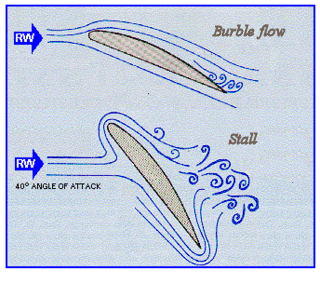Stall of the wing

The Coefficient of Lift and the Coefficient of Drag represent the changes in lift and drag as the angle of attack changes. CL and CD are not expressed by any physical unit, they are rather absolute numbers obtained from either wind tunnel tests or derived mathematically.
Initially both CL and CD increase as the angle of attack increases. At a certain point, the lift (or downforce) begins to drop while the drag increases sharply. This point is defined as the Critical Angle of Attack. If the angle of attack increases passed the Critical Angle of Attack, at one point all lift will be lost while the drag continues to increase.
Beyond this angle airflow can no longer follow the contour of the airfoil's upper surface. After the burble point, when airflow start to separate from airfoil, the airfoil goes full stall (video of aerofoil stall and CFD of same thing).
Stall can happen with all aero profiles and any other object used to produce some lift (or downforce). It can happen with airplane propeller, ship propeller, pump impeller, sails, fans and all kind of wings.
In F1 car design, stall can happen on all wings, venturis, flipups or diffuser.
Aero devices can be subjected to stall all the time, no meter what speed of the air across profile is, or stall can happened only on certain speed or certain situation.
For example, diffuser can work perfectly on strait line on smooth surface, but during cornering or on the bumps it can stall. Wing aerofoil can work perfectly until certain speed, and then suddenly stall.
It is job of aerodynamicist to solve this problem using experience, CFD, and wind tunnel.






